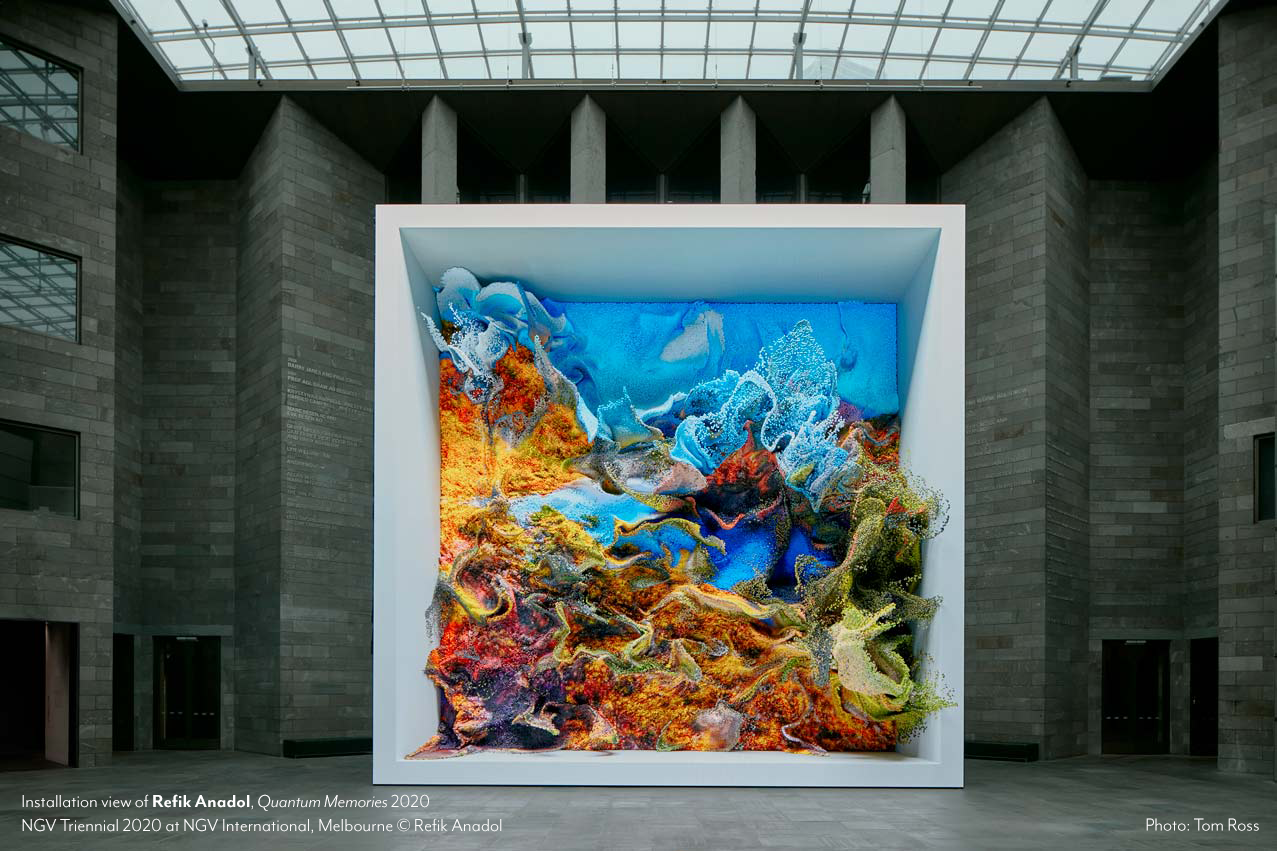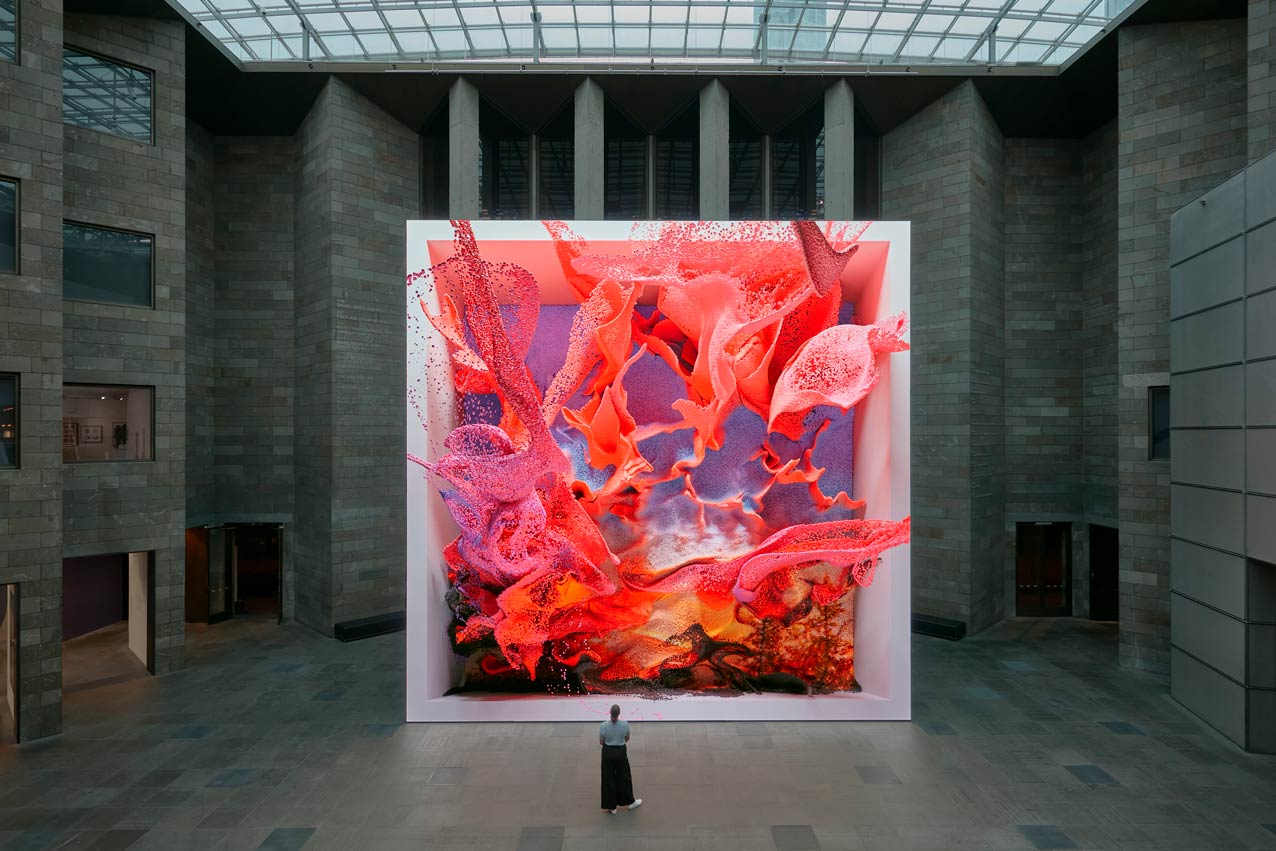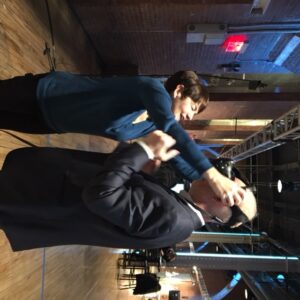By Roxanne Vardi

Dagmar Schürrer is a digital artist who lives and works in Berlin. Schürrer works with the moving image assembling found footage, digitally generated animations and objects, sound, text and drawing to create video works and AR works that explore human consciousness and perception, late capitalist paranoia, projected utopian futures, and our relationship with technological developments in the digital space.
In the following interview Dagmar Schürrer provides us an intricate account and look into her goals as an artist working with advanced technological tools to question technological progress and to understand its effects. This interview is published in conjunction with the curated artcast Dagmar Schürrer: Parallel Realities.
Many of your artworks deal with human consciousness and the complex processes of the human brain. When did you start to become interested in this subject, and what is it about the digital medium that helps in the exploration of this subject matter?
I have always been interested in the natural sciences, in particular physics and biology, the latter I even studied for a few years before my Fine Art degree. To understand how natural interrelations in our complex ecosystem work, you learn to search for recurring patterns and similarities that connect all organisms including humans and other natural phenomena. The importance of even the smallest part for the overall system functioning is basic knowledge in this field. During my Fine Art degree at Central Saint Martin ́s College of Art and Design in London, I was focusing very quickly on working with time-based media, in particular interweaving found footage with abstract moving images and soon also theoretical text fragments. In removing figurative imagery from its specific context, I was aiming to extract general patterns and through juxtaposing the imagery with abstract content, an associative space opened, where unexpected similarities were established. The addition of text fragments set a theoretical framework, in which the viewer is guided through her/his interpretations. In fact, an examination and reflection of a theoretical essay and its expression in poetic language is still the starting point of my works today.
In the following years my moving images became less film-like but more and more digital and three-dimensional. My focus shifted from the experimental filmic image and its narrativity to digital tools, new technologies and spatial installations. The impact of digitalization and new technologies on both society and the individual are at the center of my artistic practice, always through the lens of the emotional and reflective individual.
My approach is to create meditative, almost personal spaces of contemplation. The aim is to allow the viewer to ponder the manifold challenges of a digitalized society on a theoretical, visual, and emotional level. I combine theory in a poetic guise – often as voice overs – with a painterly digital composition that merges figurative imagery with abstract patterns. I constantly alter and modify these forms along the border of abstract and figurative, organic and synthetic, and emotional and material, which hopefully leads to an ambiguous tension in the digital works, suggesting the presence of multiple dimensions beyond physically experienceable and comprehensible objectivity.
“My approach is to creative meditative, almost personal spaces of contemplation. The aim is to allow the view to ponder the manifold challenges of a digitalized society on a theoretical, visual, and emotional level.”
Dagmar Schürrer, We are already history, and we don’t know it, 2021.
Digitalization and new technologies are created by and are of course closely entangled with humans. I am fascinated by the change of human self-perception parallel to the increase of knowledge, scientific progress, and the advancement of new technologies. These developments seep into society and directly influence our interpretation of what it means to be human and how we live in this world, and at the same time feed back into technological, scientific, and artistic research. For me this is directly connected to human consciousness and the functioning of the brain. The brain has often been described by technological metaphors. In the past the brain was seen as a centralized machine that works from the top to down and controls all movement and behavior. In the digital age it resembles a computer running its programs. And with the rise of artificial intelligence, we will get another step closer to a better understanding of how the human brain functions and new metaphors will emerge. These metaphors also have a great impact on how we see the human in relation to society, the environment and even concepts like time and space.
While researching into the interrelation of consciousness and technological developments, I was studying the work of French philosopher Catherine Malabou, in particular her essay “What should we do with our brain?”. In it she discloses how contemporary metaphors used to describe the brain in neuroscience closely mirror the language used for technology, and as it is even the political and societal structures of a neo-liberal capitalist world: decentralization, networks, flexibility, fluidity, simulation, etc. She argues in favor of using the term “plasticity” – the lifelong ability of the brain to develop, to influence the environment around it and to be formed by constant inputs – which allows for active involvement and exchange. The brain became the central subject of my media installation We are already history, and we don’t know it. Within three animations and an augmented reality (AR) application a voice over contemplates the analogies between the organ and contemporary technologies, juxtaposed with computer generated imagery reminiscent of cell structures, neuronal tissue, or electric wiring. The virtual additions of the AR app connect the animations and invite the user for a spatial exploration of the installation.
In Dreaming is the mind left to itself I deal with similarities between different states of consciousness – the waking reality, the digital realm, the dream world, drug induced conditions, spiritual meditations – and our feeling of individual presence in them. Each of them having their purpose and allowing humans to access different constructions of reality. In particular the role of dreaming has fascinated artists and researchers for a long time. The neuroscientific theory “The Overfitted Brain Hypothesis” (OBH) compares dreaming to a certain aspect of Artificial Intelligence (AI). For AI to deliver meaningful results it needs to be fed with a sufficiently variable dataset. To increase variations, it can be interspersed with noise and glitches. OBH draws parallels to the purpose of dreaming and argues that it works as a similar noise injection, so our brain can cope with the many self-repeating patterns during waking world. The AR video installation “Dreaming is the mind left to itself” leads the visitor through abstract dreamscapes and digital environments, focused through a vignette reminiscent of Virtual Reality glasses. The imagery becomes more and more enmeshed, suggesting the dissolution of the parallel realities.
Dagmar Schürrer, Dreaming is the mind left to itself, 2022.
“I am fascinated by the change of human self-perception parallel to the increase of knowledge, scientific progress, and the advancement of new technologies.”
Can you dive a bit deeper into your interest in Augmented Reality as a critical tool to question the future, specifically in terms of technological advancements?
Augmented Reality (AR) is the first visual tool, with which you can truly merge the digital and analogue space and blur their borders. I am excited about the possibility that my computer-generated environments can literally leave the screen and mingle in our daily environment – the analogue realm. AR allows new forms of presentation of art outside the white cube. It is easy to access AR works at places like home or in public space, as many people have a compatible smartphone or tablet. Quite a lot of the pioneering AR works were created in an activist spirit – logo hacking or museum hijacking – as you can communicate on an invisible meta layer, which you need to know how to activate. In the future AR-glasses will gain importance, at the moment they are still very expensive and also slightly restrictive in their visual quality. The glasses will increase the immersive experience and digital content could seamlessly blend into every day’s life. The more the technology advances the more it will be integrated in our routines and have an impact on many aspects of society. Therefore it is important that artists explore new technologies, and don’t just leave them to commercial corporations and big tech. We can learn about the impact of these tools when we create with them, use them, and reflect about them without commercial objectives. This allows both creators and viewers to train their media competence and technologic languages to develop the skills to critically question technological progress and understand the effects. In an ideal world an aware society could implement ethical and responsible use of these technologies.
In some sense, do you fear that technology will outsmart the human brain? That the post-digital age is not only a mirror of society but a warning sign to what is to come?
Maybe I can’t think that far ahead, but I am not really concerned that technology will outsmart us. What is more worrying is the distribution of power and access among humans. Who can use technology for what, and how can we regulate that without cutting individual and creative freedom. The programming of technology is done by humans, including both positive and negative perceptions. Of course, technological tools are somewhat addictive, and it is easy to get lost with and in them, which obfuscates their far-reaching effects on many meta levels. Media education is really important to be able to navigate through this complex and subtle process of development.
Pierre Levy, author of Becoming Virtual, Reality in the Digital Age, argues that the Virtual is not the destruction of the personal but in fact a transformation, thus it will not replace the Real, the Possible, and the Actual. Do you agree with Levy’s proposition? How do you see the Virtual differentiating from the Possible in line with Pierre Levy’s belief?
The ideas elaborated in “Becoming Virtual, Reality in the Digital Age” were the starting point for my AR Video installation “Virtualized”. Levy proposes that one should not think about the Virtual as the supplement or even the opposite of the Analogue, but rather its continuation, and proposes to overcome a dualistic way of perception. He circumvents this problem by introducing four modes-of-being: Reality, Possibility, Actuality, and Virtuality, as well as the various transformations between them. This allows us to see the Virtual not as imaginary or illusory, but as a full-fledged state of existence beyond the immediate physical presence. One could say that the Real and Potential contain manifest things, while the Virtual and Actual can be rather seen as dynamic events, or “a continuously reviewed problem rather than a stable solution”. Reality implies a material embodiment, a tangible presence. The Possible is the same as Reality, only missing physical existence. The Virtual on the other hand is detached from the here and now, cannot be precisely located, is nomadic and dispersed and has no stable point of reference. As Levy puts it, “virtualization comes as a shock to traditional narrative”.
“Becoming Virtual, Reality in the Digital Age” was written already in 1998, so I think it is quite visionary to label the different digitized states-of-being as separate entities with their own parameters and characteristics. In my work Virtualized I was trying to translate these rather complex theories into an audiovisual manifestation. The two thoughts I was mainly focusing on were on the one hand dispersion and fragmentation, fitting well with my method of establishing patterns and similarities by creating an associative narrative and visual space, and on the other hand the question of physical materiality. Only one of the four modes-of-being is manifested in the physical, what does that mean for the importance of physical presence and, what is non-physical materiality? How can materiality and the idea of haptics be communicated in the digital?
Your work, GALAXY, presents to its viewers a story about an encounter of love and disappointment told and generated by an algorithm. Could you elaborate on the creative process here and what rules are given to the software to generate this narrative?
GALAXY is in a way quite different to my other works of the last few years, as the text is not written solely by me and the analysis of narrativity takes a central role again. It is a nice bridge to my earlier works in experimental film. The story is created with a fairly straightforward text writing algorithm. You feed the generator the essential parameters: some key words you want to include, what kind of genre you aim for, the overall mood of the story, if it should have a bad or happy ending, etc. The result is a simple and not very sophisticated short story. The exciting thing was, that it was quite a “bad” generator, the algorithm was not very successful in simulating a meaningful structure of sentences. It showed weird deviations in the language and the narrative logic, and it fabricated great obscure sentences like: “They looked at each other with quiet feelings, like two shy snakes stroking at a very gentle stream, which had electro music playing in the background and two noble uncles swiping to the beat.” For me the glitches and imperfect simulation were certainly the strength of the generator. As soon as the illusion is perfect, it becomes pretty boring.













